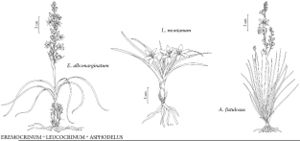Asphodelus fistulosus
Sp. Pl. 1: 309. 1753.
Plants annuals or short-lived perennials; root crowns thickened with many fibrous-roots. Stems branched or unbranched, 20–70 cm. Leaves 5–35 cm × 2–4 mm; blade cylindrical or slightly flattened adaxially, hollow, glabrous except on margins. Inflorescences simple racemes to open panicles with ascending branches, 15–70 cm; bracts white, 4–7 mm. Flowers diurnal, closing in evening and during cloudy weather; tepals white to pale-pink, oblong, obtuse, 5–12 × 2–3 mm, vein dark-pink or brown; longest stamens equaling style. Capsules 5–7 mm, transversely wrinkled. Seeds 3–4 mm, rugose. 2n = 28, 56.
Phenology: Flowering late winter–spring.
Habitat: Roadsides, fields, waste places
Elevation: 0–1400 m
Distribution

Introduced; Calif., N.Mex., Tex., sw Europe, sw Asia, n Africa, widely naturalized (Australia), widely naturalized (Mexico), widely naturalized (New Zealand), expected elsewhere
Discussion
Asphodelus fistulosus has become a noxious weed in California and in other places with Mediterranean climates worldwide.
Selected References
None.
Lower Taxa
"broad" is not a number."thicker" is not a number.
